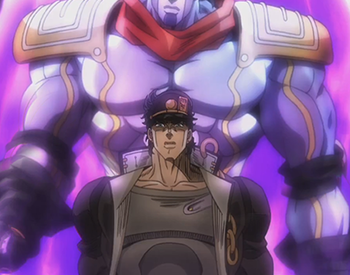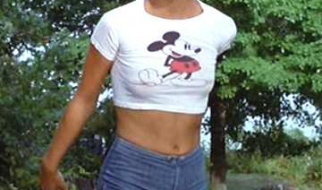Big Spoilers for JoJo?s Bizarre Adventure ahead.
Ask anyone who is a fan of JoJo?s Bizarre Adventure what makes the show/manga so special, and they?ll tell you it?s the over-the-top action, the sincerity of the relationships, and the extremely flexible lore. JoJo fans are known for their passion for the franchise, to the point that ?Is that a JoJo reference?? has become a meme both used to mock fans, as well as one eagerly deployed by them. For the record, sometimes it is a reference to JoJo, and sometimes fans are just overhearing someone talk about Queen or Prince. It?s action-packed, full of classic rock and pop culture references, with a massive cast of interesting, flashily-dressed characters. Most people would tell you that above all else, JoJo is FUN. I am here to argue that as fun as it is, JoJo is actually about inevitable and inescapable failure.
That?s a bummer. Let?s avoid the bummer for now by explaining the premise for the uninitiated. JoJo?s Bizarre Adventure follows multiple generations of the Joestar family as they face down various supernatural threats. At first, they do so using a power called Hamon, or ?The Ripple.? However, beginning in Part 3 (Stardust Crusaders), characters begin to use something called a Stand. Stands are essentially manifestations of a person?s fighting spirit, and usually take a separate form outside of the person themselves. Many of them literally look like robots or superheroes or something, though some are more abstract, taking the form of say, vines that grow from the user?s hands, or an army of little soldiers. Stand powers vary wildly, from the ability to simply hit hard, to the ability to change what people look like, and even the ability to manipulate time. Each part in JoJo features a central character whose name can usually be shortened to JoJo, although protagonists (i.e. JoJos) from other parts usually also appear.
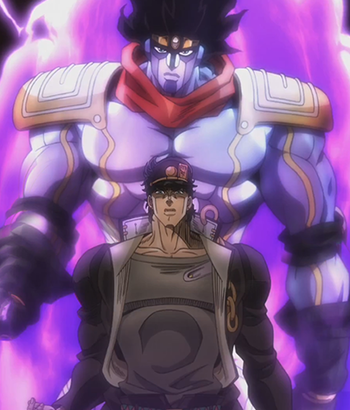 Jotaro and his Stand, Star Platinum. Courtesy: Lucky Land.
Jotaro and his Stand, Star Platinum. Courtesy: Lucky Land.
Failure can be a useful concept in thinking about JoJo, especially in the compromised ways in which the heroes of each part ?win,? but then also in the ways in which those victories are later erased or undermined. Compared to a more standard Shonen manga like Dragonball, where Goku completely destroys all of his enemies (or chooses to spare them), the various JoJos seem downright sloppy. Let me illustrate a few of these failures.
In Part 1, Phantom Blood, Jonathan fails to permanently defeat Dio, setting up his return in Part 3, Stardust Crusaders. He does the best he can, but is eventually beheaded by his vampiric foster brother, who then steals his body. This has lasting implications for the rest of the series, as Dio returns and as his devotees try to carry his plans through.
Part 2, Battle Tendency, ends with Jonathan?s grandson, Joseph, failing to kill the last of the Pillarmen. He launches the ancient vampire into space instead. It?s unambiguously a defeat, but it?s always theoretically possible that Kars could return.
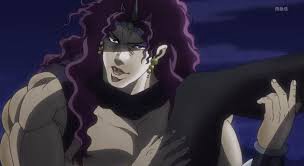 Kars is never fully defeated by Joseph. Lucky Land/Araki.
Kars is never fully defeated by Joseph. Lucky Land/Araki.
Parts 3, 4, and 5 largely deal with the aftermath of Dio?s survival. Part 3, Stardust Crusaders, deals with the need to defeat Dio before he can kill Joseph?s daughter, Holly. To do this, he teams up with his grandson Jotaro and a bunch of other guys (and a dog). Jotaro kills Dio after learning how to stop time. It turns out that the abilities that manifest themselves as ?Stands? come from an ancient bow and arrow.
Part 4, Diamond is Unbreakable, takes us to the Japanese town of Morioh, where Joseph?s illegitimate son Josuke lives. Jotaro, Josuke, and friends learn that the arrow has made it?s way to Morioh, and try to contain it while also hunting down a powerful serial killer.
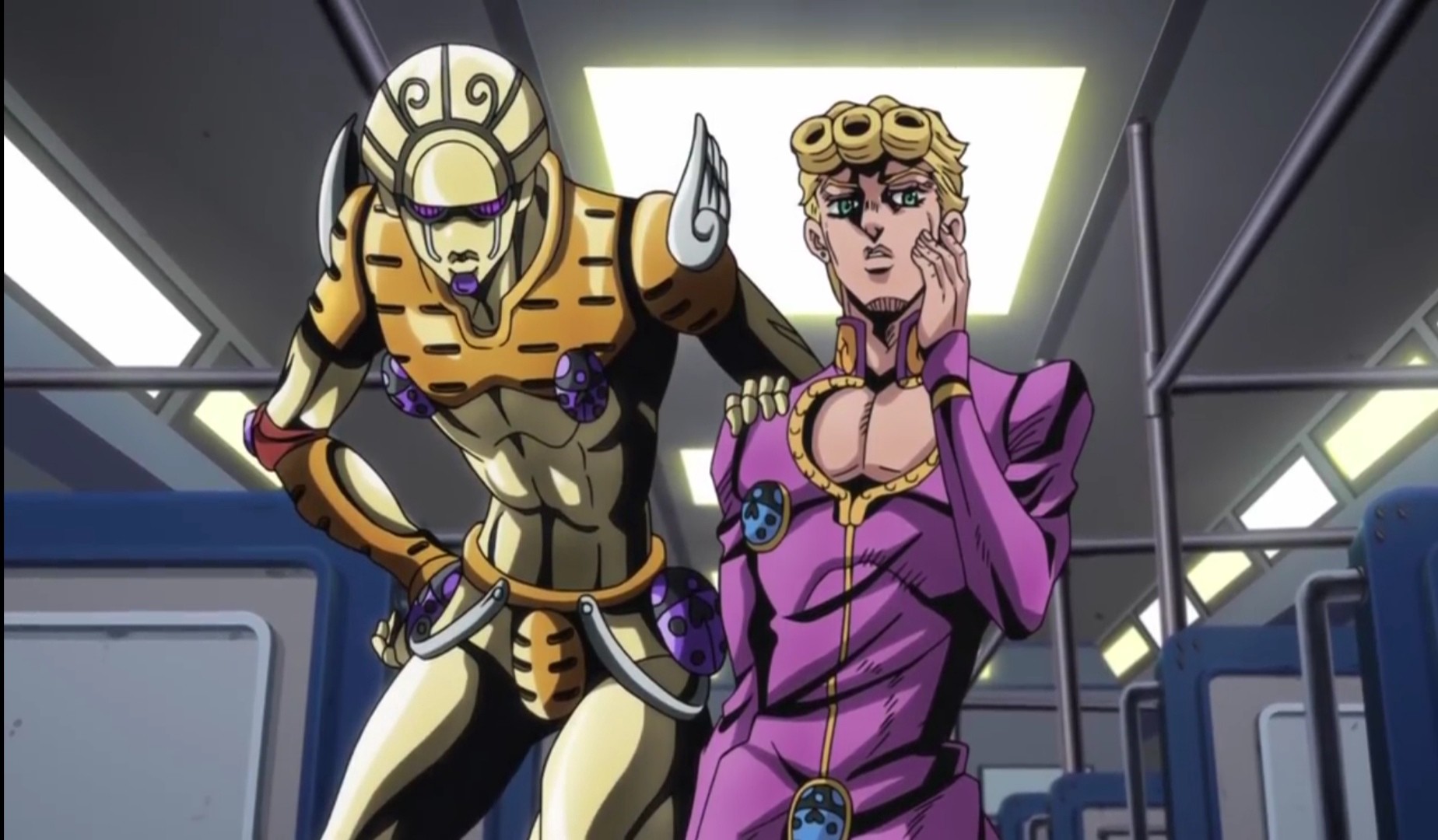 Giorno Giovanna and his Stand, Gold Experience. Lucky Land/Araki.
Giorno Giovanna and his Stand, Gold Experience. Lucky Land/Araki.
Part 5, Golden Wind, follows Dio/Jonathan?s son Giorno, who uses his stand powers to take over a criminal organization called Passione, while learning even more about the arrows. Polnareff, one of the companions from Stardust Crusaders, kind of dies in the final fight, but has his soul transferred into a turtle.
Part 6, Stone Ocean, is where everything comes to a head. Father Pucci effectively runs the prison where Jolyne, Jotaro?s daughter, is being held after being framed by a boyfriend. Pucci is a disciple of Dio, and wants to use Dio?s knowledge to ?attain heaven? by fast-forwarding time to create a new universe. In the process, he kills Jolyne and Jotaro. He is not defeated until he enters the next universe, where he is killed by Emporio, one of Jolyne?s friends. This is the big failure: two JoJo?s are killed and Dio?s ultimate plan is enacted, even if the villain is eventually killed. The universe of the first six parts is gone.
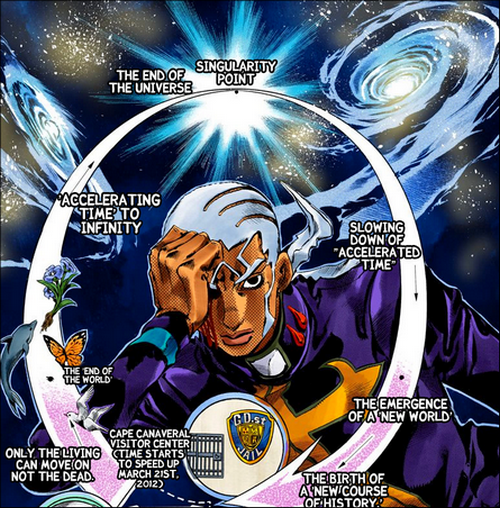 Father Pucci successfully restarts the universe. Lucky Land/Araki.
Father Pucci successfully restarts the universe. Lucky Land/Araki.
Part 7, Steel Ball Run, takes place in a whole new universe. Johnny Joestar is an American jockey who, and this is literally the plot, must take part in a cross country horse race in order to prevent the president of the United States from gathering all of Jesus? body parts. In another series, JoJo would do so and win the race. He technically does neither. He definitely loses the race, but in addition, it?s Lucy Steele, the wife of the race?s organizer, who prevents an alternate universe Dio from snagging the corpse for himself. Johnny tracks her down after she?s defeated Dio, and helps her lock away the corpse in a church vault.
It?s supposed to sit in that that vault for 80 years, but Part 8, JoJoLion, reveals that Johnny broke it out of captivity early, leading to a series of events that causes his head to be crushed by a rock.
To sum up, the various JoJos? record on actually defeating their opponents are spotty at best. Nearly all achieve some form of victory, but all heroes also seem to falter at some point. Aside from numerous companion deaths, there are the fates of the various JoJos to think about. Jonathan is killed and has his body stolen by Dio. Joseph doesn?t die on the page, but the last we see of him, he?s a doddering old man trying, and failing, to connect with his son Josuke. Jotaro is killed by Pucci. Josuke and Giorno seem okay, but we don?t know what became of them after Pucci attains Heaven. Jolyne dies alongside Jotaro. Johnny is crushed by a rock. The current JoJo, Josuke 2, is still in the middle of his journey, but there?s lots of room for heartbreak.
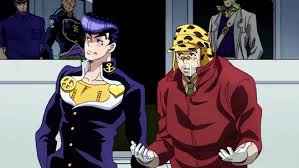 An elderly Joseph with Josuke. Not quite a death, but a fall from Grace. Lucky Land/Araki.
An elderly Joseph with Josuke. Not quite a death, but a fall from Grace. Lucky Land/Araki.
I realize I?m running the risk of making this bright and fun action series into a dark meditation on the futility of all things. But the thing is, if all things are futile, that goes for the villains as well. Dio?s plan to attain Heaven may have eventually succeeded, but it was Pucci who did it, and was then beaten by a child. Although the JoJos largely seem to die a little young and sometimes in horrible ways, they also generally have a lasting positive impact on those around them, and there?s always another JoJo. Even the most morally dubious of them, Giorno, took over the mob and then got them to stop dealing drugs.
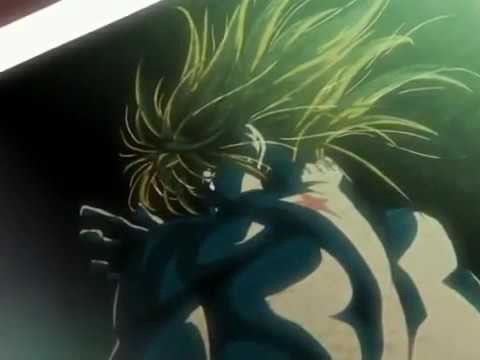 Dio with Jonathan?s Body, displaying the Joestar birthmark. Luck Land/Araki.
Dio with Jonathan?s Body, displaying the Joestar birthmark. Luck Land/Araki.
But that?s important because it signals something about how JoJo?s Bizarre Adventure works: It?s always been about the journey. Every part deals with a character who grows, but who never reaches a true ?end.? Jonathan literally grows from a young aristocrat to a hero who sacrifices himself to save his wife. Joseph begins as a hot-headed young man afraid of upsetting his Granny and ends up marrying and starting a family. Then starting another family when he cheats on his wife (oops). The first things we hear out of Jotaro?s mouth are him calling his mom a ?bitch.? He risks his life to save her and grows up to have his own complex relationship with his child. The pattern goes on, but for each protagonist, there is growth, there are setbacks, there is conflict, and sometimes there is reconciliation.
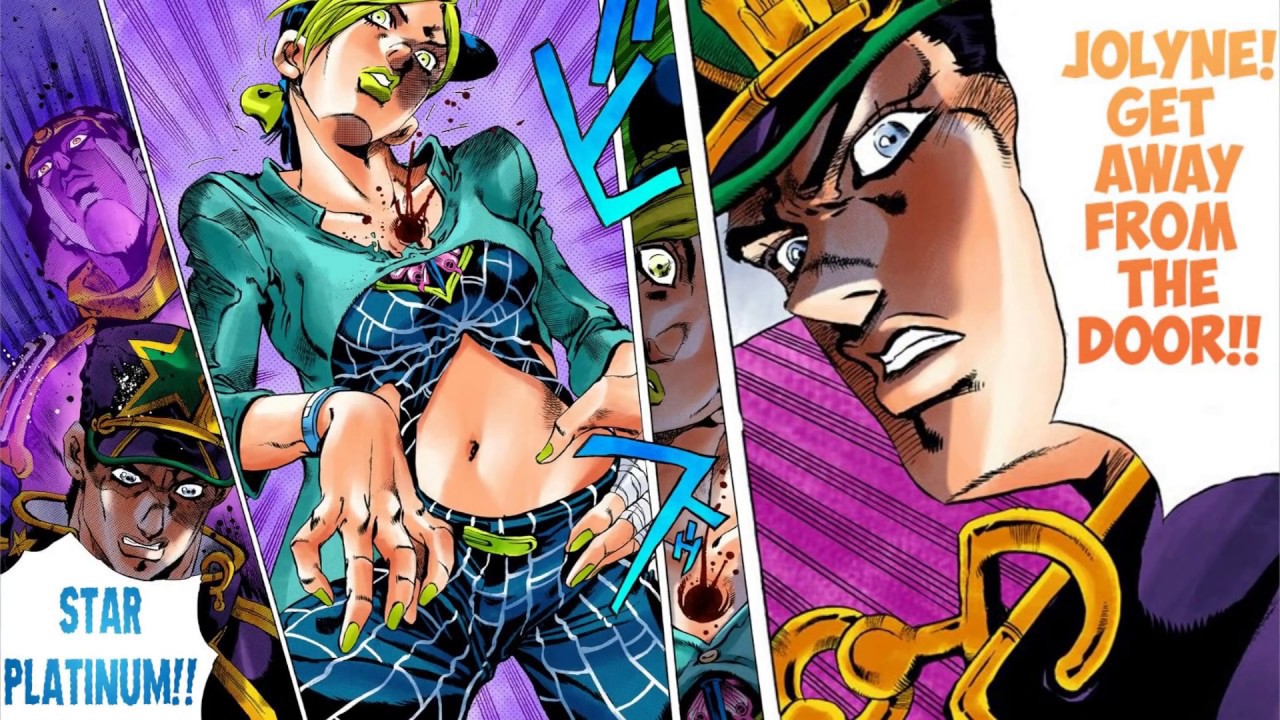 Jotaro and Jolyne have a somewhat challenging reunion inside Green Dolphin Street Prison. Luck Land/ Araki.
Jotaro and Jolyne have a somewhat challenging reunion inside Green Dolphin Street Prison. Luck Land/ Araki.
Despite the big showdowns and major sacrifices that conclude nearly every part, the story, JoJo?s Bizarre Adventure, continues on. To me, that?s a hopeful message. It reflects that the world goes on even in the face of failure. That even if we exit the story, there are others to carry on. It tells us that failure is a part of life, but that?s true for everyone. JoJo?s Bizarre Adventure deploys failure in a way that is massively useful in shaping a narrative of hope. After all, it?s the Adventure that ultimately matters most.
